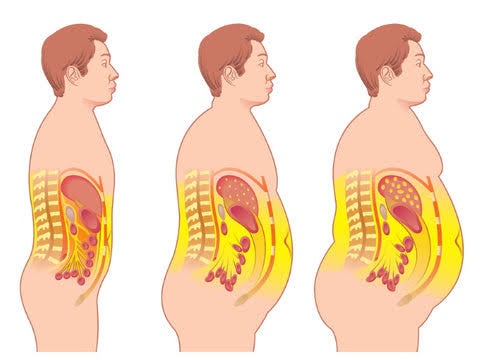
Visceral fat in the body, also known as “hidden” fat, is fat stored deep in the abdomen, which is wrapped around the organs, including the liver and intestines, and it makes up about a tenth of the fat stored in the body; Most of the fat is stored under the skin, known as “subcutaneous fat”, which is the visible fat, which you can feel, while the rest of the fat in the body cannot be felt; ie “visceral fat”.
Visceral fat makes the abdomen prominent, or gives a person the shape of an “apple.” It also produces chemicals and hormones that can be toxic to the body, so it is more dangerous than subcutaneous fat, and in thin people, visceral fat also carries a range of health risks, while These fats are more common in men than women.
What causes visceral fat?
Fat is stored when you consume a lot of calories and do very little physical activity, as some people tend to store fat around the abdomen rather than the hips due to their genes.
In women, aging can change where fat is stored in the body, especially after menopause, while a woman’s muscle mass decreases and her fat increases. As women age, the likelihood of developing visceral fat in the abdomen increases, even if the woman has not gained weight.
In men, age and genes also play a role in the development of visceral fat.
What are the health risks of visceral fat?
The presence of visceral fat in the abdomen is a sign of metabolic syndrome, a group of disorders that includes high blood pressure, obesity, high cholesterol and insulin resistance. Together, these factors increase the risk of stroke, heart disease, and type 2 diabetes. Having too much visceral fat in the abdomen can also lead to:
– mental illness.
– Cancer.
– Asthma
– Liver diseases.
– Gallbladder and gout.
Fertility problems.
– lower back pain.
Spinal pain.
Perhaps the best way to find out if you have visceral fat is to measure your waist. Waist circumference is an indicator of the amount of fat found in the depths of the abdomen and around the organs. For women, the risk of developing chronic diseases increases if the waist circumference is 80 centimeters or more, and for men it is 94 centimeters or more. While these measurements don’t apply to children or pregnant women, if you think your waist measurement might be too big, talk to your doctor. Body mass index (BMI) may also indicate the amount of fat in the body
How can visceral fat be reduced in the body?
Exercise helps lose visceral fat
The best way to reduce visceral fat is to lose weight and eat a healthy diet. Visceral fat responds better to diet and exercise than thigh fat, and regular exercise can also prevent the return of visceral fat.
Another option for reducing visceral fat is medication, but studies show that it is not as effective at reducing visceral fat as exercise, and regular exercise can also prevent the return of visceral fat.
Although you can’t change your genes, hormones, or age, you can reduce your risk of disease from too much visceral fat by:
Exercising for at least 30 minutes each day (eg brisk walking, cycling, aerobic exercise, strength training).
– Eat a healthy diet.
– Non-smoking.
Reduce sugary drinks.
Get enough sleep.






